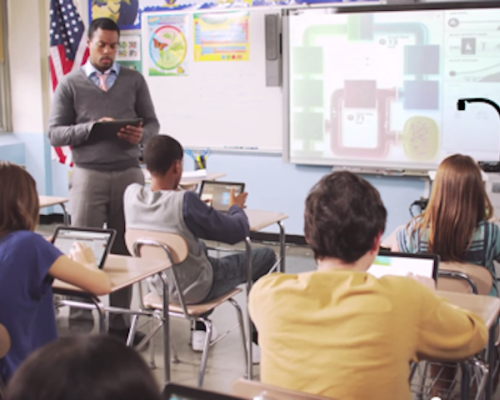Envisioning the Future of Mobile Learning
Date
At a recent conference, my suspicions were confirmed: no one else really has a clue to what the future of mobile learning looks like. The solution is getting more ideas out on the tablet.
This is a screenshot taken from a video about the future potential of mobile learning. After highlighting a few interesting and truly promising ideas, this scene simply reduced mobile learning to a traditional classroom paradigm. Is this what the future holds?
As the momentum builds for the promise of mobile learning in the classroom, so does the need for inspirational examples that demonstrate different ways of teaching and learning. These inspirational examples aren’t about promoting a product or solution for a specific problem, but to look much further ahead and provoke creative thinking about new concepts or ideas. Instead, they should address questions like: What does a mobile learning classroom look like? What does teaching look like? Where does learning take place?
If the education industry (whether from the vendor or institution side of the same coin) doesn’t start doing this with educational technology (and mobile learning specifically), we risk missing a massive opportunity for reinventing what teaching and learning is for generations to come.
Why does this matter?
Using a process of developing forward-looking inspirational examples unencumbered by present-day constraints is a fundamental ingredient for enabling continuous innovation in several design fields: automotive, fashion and aerospace are just three obvious examples. Just imagine what these industries would be like today if it weren’t for concept cars, haute couture, and science fiction.
Making this work for the future of education
Given that the field of education (where some say the rate of change is slower than that of glaciers) has always struggled with innovation, perhaps a missing ingredient we can borrow from these other fields is a heavy dose of “ed-fiction”: inspirational examples that demonstrate new concepts and ideas for teaching and learning. Just as most concept cars don’t actually start up and drive off the stage, these vignettes don’t have to necessarily address present-day constraints (unless, of course, that’s its goal).
Fail early, fail often, but always rinse and repeat
It’ll be difficult for the education industry to embrace this process because it’s inherently messy. As any designer will tell you, it takes dozens of bad ideas to come up with one good one. It’s about having a different frame of mind: exploring new concepts or ideas is about envisioning the future and not trying to solve today’s problems. Right now, the education industry has but a few examples (and that’s counting as far back as Knowledge Navigator, 1987!). Without more, these risk becoming authoritative references, being referenced in policy or teacher education programs and ultimately missing the opportunity to inspire true innovation in teaching and learning.

